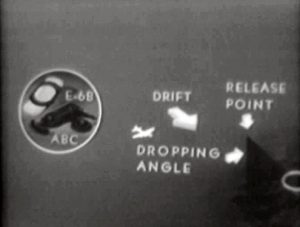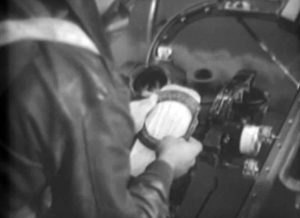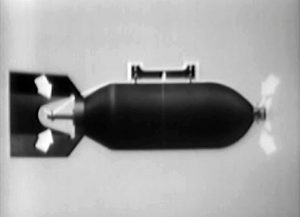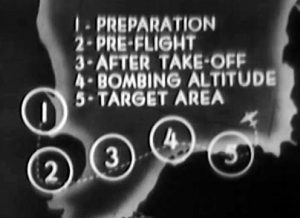
During World War II (WWII) Walt Disney Productions produced over two hundred training films for various branches of the United States Military and other U.S. Government departments. Many of these films were created in cooperation with The First Motion Picture Unit Army Air Force (A.A.F.). The First Motion Picture Unit A.A.F. was a training film unit that was made up of film industry professionals who served during the war doing what they did best, making films. The unit included well-known actors of the day including Clark Gable, Ronald Reagan, DeForest Kelly and others. The animation department of the First Motion Picture Unit A.A.F. unit was staffed with now legendary animators like Rudolf Ising, Jules Engel, John Hubley as well as Frank Thomas, one of Disney’s Nine Old Men, among many others. By June 1942 the Disney Studios was designated a war plant and was turning out war related training, entertainment and propaganda films.(see footnote 1, below)

The E-6B and ABC computers were designed to calculate the Dropping Angel, Drift and Release point for the Bombardier on a typical air raid bombing run. In the HIGH LEVEL PRECISION BOMBING training film this was indicated using simple graphic animation techniques.
Many of the training films that Disney was involved with producing would have been damaging to national security if they were leaked out especially the films that demonstrated new weapons or technology that was cutting edge for the day. One such film, created in 1943 is High Level Precision Bombing that dealt with the Bombing Computers in Part 1 and explained Combat Bombing Procedures in Part 2. Both parts explained techniques for more precise targeting of bombs dropped from high altitudes. During production, the film was known as the Colonel Garland Project. The purpose of this film was to make it possible to maximize intended target damage with more precise bomb deployment while at the same time limiting the unintended collateral damage to other structures and civilians.
Like many other training films that Disney created, HIGH LEVEL PRECISION BOMBING Part 1 is a very dull and straightforward instructional film. There are no animated book ends like there are in STOP THAT TANK, which had some first-rate full animation as entertainment value to an otherwise dry film showing how the Boys Anti-Tank Rifle was operated.

The Index card in the E-6B computer as the Bombardier makes his calculations before entering the results into the Norden Bombsight, which can be seen in the background.
The film moves onto its stated purpose of more accurate bombing with the use of the bombing calculators known as the E-6B and the A.B.C. computers. These are not digital computers that we use to today but analog computers—think slide rulers. The E-6B uses index cards filled with rows and columns of numbers. The A.B.C. (Automated Bombing Computer) is a dial and sliding scale that align the wind speed and direction into the Norden bombsight.

An example of the simple graphics peppered throughout this training film. The circular scale fades on in sync with the narration as the small plane remains stationary with sky and clouds panning in the background.
The second half of the film, Part 2—Combat Bombing Procedures, is mostly live action of a bombardier going through the rigid procedures for a bombing mission on an enemy target, which are preparation, pre-flight, after take-off, bombing altitude and target area. Interspersed throughout this section of the film are graphics done with very rudimentary animation techniques. Although this is basic animation it is no less important to the integrity of the information being discussed. In fact, it is vital to the subject matter as this is the only practical way to effectively demonstrate the material being disseminated. For instance, showing the location of the shackle releases and checking the arming wires and fuse spinners on a bomb is better done with a diagram for safety and clarity sake.

A still frame from an animated scene that shows a diagram of a bomb with the shackle releases, indicated on the top of the bomb, and arrow animation pointing to the location of the arming wires at the rear and fuse spinners at the front.
Much of the animation that was produced by Disney for these films was done in separate units within the studio with neither unit of artists knowing what the other was doing according to an interview I did with Joe Grant in the early 2000s. Grant was one of those artists involved with many of the war related films. In High Level Precision Bombing Parts 1 and 2, it is likely that the animation in each part was done by two separate units. This was a security measure, no-doubt implement by military protocol, so one artist or unit of artists would not know what the entire film was about as these were all listed as restricted (confidential). Looking at the limited quality of the animation in these films, my sense is that much of this artwork was created quickly and elements reused in multiple projects. Since there are no credits, it is difficult to determine exactly who worked on these films especially since most were completely— film, negatives, artwork, etc.— removed from the studio property at time of completion. In fact, there are a number of the WWII films that do not exist in the studio’s film library, including High Level Precision Bombing Parts 1 and 2.

The animated graphics that fade on in sync with the narration, “Combat procedures laid out in its five phases is designed to get you to your target to do your job.”
It was these U.S. Government contracted films that not only kept the studio afloat financially during WWII, but it also proved that there was a much wider application for the animation and cartoon camera techniques that the studio developed for their entertainment shorts and features. Walt Disney had the foresight to see that animation was a logical medium for use in explaining often complex concepts with simplified artwork in motion in order to make the subject matter easily understandable. It was a more practical way of showing the inner workings of new devices that could not have been achieved in live action photography. His genius was not just in storytelling, but in his creative agility to find solutions to the unpredictable and changing marketplace with an eye on keeping the studio thriving, or at the very least solvent, during turbulent times.
FOOTNOTES
1 – Service with Character, by David Lesjak, pg. 7
2 – Part 1, Sec. 1.2, “Executive Order 13526 of December 29, 2009, “Classified National Security Information””. Federal Register – U.S. National Archives and Records Administration, Vol. 75, No. 2, p. 707. January 5, 2010.
3 – Quoted narration from the film High Level Precision Bombing, Part 1 The Bombing Computers, 1943
4 – Quoted narration from the film High Level Precision Bombing, Part 1 The Bombing Computers, 1943
5 – Quoted narration from the film High Level Precision Bombing, Part 2 The Bombing Computers, 1943


 David A. Bossert is an award-winning artist, filmmaker, and author. He received his B.A. from CalArts School of Film and Video with a major in Character Animation. As a 32-year veteran of The Walt Disney Company, he contributed his talents to The Black Cauldron (1985), Who Framed Roger Rabbit (1988), The Little Mermaid (1989), Beauty and the Beast (1991), Aladdin (1992), Tim Burton’s The Nightmare Before Christmas (1993), The Lion King (1995), Fantasia/2000 (1999), and the Academy Award-nominated shorts Runaway Brain (1995), Dali/Disney Destino (2003), and Lorenzo (2004), among many others. Bossert is now an independent producer, creative director, and writer.
David A. Bossert is an award-winning artist, filmmaker, and author. He received his B.A. from CalArts School of Film and Video with a major in Character Animation. As a 32-year veteran of The Walt Disney Company, he contributed his talents to The Black Cauldron (1985), Who Framed Roger Rabbit (1988), The Little Mermaid (1989), Beauty and the Beast (1991), Aladdin (1992), Tim Burton’s The Nightmare Before Christmas (1993), The Lion King (1995), Fantasia/2000 (1999), and the Academy Award-nominated shorts Runaway Brain (1995), Dali/Disney Destino (2003), and Lorenzo (2004), among many others. Bossert is now an independent producer, creative director, and writer.













































































For some reason, i can’t get enough of WW2 training films, as stilted and repetitive as they often are.
Given the chance, I’m pretty sure I could run-up and taxi a B-25. 😉
Just hook up with the owners of one of these airworthy B-25s and see what happens.
https://b-25history.org/hangar/flying.htm
OK, Dave, if High Level Precision Bombing pts. One and Two are lost films, how come you can quote the narration from them chapter and verse and know the details of what was covered in the pictures? Maybe you have your own copies? If so, can you put them on the Internet so we can see them?
Hi Mark,
Yes, this was a lost film as the studio does not have a copy of it in there film library, which is the case for some others. I only recently found a low-res copy of the film after much time, research and digging. I was able to transcribe the narration and pull some stills that had to be fixed up in Photoshop. I will get them uploaded at some point. Thanks for reading the article, I hope you enjoyed it.
-Dave
Really appreciate all the time and effort you are putting in to find and restore these films. Thank you!
Thank you! I appreciate you comment. The hunt continues to find more of these films.
Hello Dave,
I have a very large collection of WW2 films that Disney helped animate or produce. This collection came from a collector in Italy who spent many years putting in together. I’d be happy to share some if these films with you. I’m a Disney archivist who has a large collection of Disney video from 54 to present. Please feel free to contact me if you like. bugsplat9999@verizon.net